Everything you wanted to know about Alexander’s depressed larynx but were afraid to ask
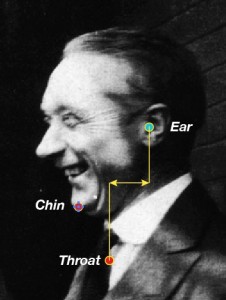 I have seen recently a few articles written by some Alexander teachers about the supposed “dangers of having the head forward and up”. This reminded me of how little the modern AT schools train their students to analyse rationally and experiment practically with the written premises of the Technique of direction of the general use of the self in relation to functioning and to the manner of reaction. This, and a question1 about the same subject by one of the teachers of the modern Alexander technique undergoing post-graduate training with me prompted to re-write this old article to offer an example of a reasoned analysis on a reasoned plan.You remember certainly that F.M. found he was “pulling back the head”, “depressing the larynx” and “sucking his breath in”2 in the introduction of “The Use of the Self”.
I have seen recently a few articles written by some Alexander teachers about the supposed “dangers of having the head forward and up”. This reminded me of how little the modern AT schools train their students to analyse rationally and experiment practically with the written premises of the Technique of direction of the general use of the self in relation to functioning and to the manner of reaction. This, and a question1 about the same subject by one of the teachers of the modern Alexander technique undergoing post-graduate training with me prompted to re-write this old article to offer an example of a reasoned analysis on a reasoned plan.You remember certainly that F.M. found he was “pulling back the head”, “depressing the larynx” and “sucking his breath in”2 in the introduction of “The Use of the Self”.
This discovery and all the following discoveries described in the first chapter of the book were not made by scanning or deepening his feeling sense, but by observing the concerted movements of the different parts of his organism in action in a mirror when he was guiding himself with definite verbal instructions3: this was conscious guidance.
Conscious guidance and control was never fully abandoned by Alexander, even if he decided to teach using more and more sensory experiences (subconscious guidance) transmitted through authoritarian manipulations. In his last book, in 1942, the “new principle” borrowed from Ralph Waldo Trine in the first book, msi (1910)4 makes a remarkable entry:
In this whole procedure we see the new principle at work, for if we project those messages which hold in check the familiar habitual reaction, and at the same time project the new messages which give free rein to the motor impulses associated with nervous and muscular energy along unfamiliar lines of communication, we shall be doing what Dewey calls “thinking in activity.” (Alexander, F.M., “The universal constant in living, Chaterson L.t.d., 1942, third edition 1947, p. 91)
I had imagined that, because he was talking about incorrectly concerted movements which he could see in the mirror and not movements he could feel (everyone knows that feelings cannot be expressed in words), my teachers would be able to describe these movements in words and schematic forms, but I was disappointed. I heard things like “nodding the head by a release of the neck muscles will free your breathing“, and other authoritarian comments, but nowhere could I find a rational explanation of the relationship between the depressed larynx and the pulling back of the head. I do not think that anyone knew that “depressing the larynx” was a particular movement.
Alexander himself never made plain what he saw in the mirror about his larynx and the expression “depressed larynx” never transmitted a clear signification to me. Curiously, I could not find anybody to give me a clear description of the linked conditions Alexander was starting with and even less a rational explanation during my own training course. The first generation teachers that I met at the time were curiously evasive about the subject.
Everybody acted as if “depressing the larynx” or “pulling the head back” were obvious, unambiguous actions, and no one had made any experiment to test what they could be nor how they were precisely related. It is clear that if you possess a ‘solution’ for all ailments, a solution which you can transmit subconsciously by touch, there is no point in investigating Alexander’s problem!
Alexander had started investigations in a new field of practical experimentation upon the living human being (Alexander, Uos, p. 15), but by the time I started my training, the practical experimentation upon oneself brought about by using definite instructions of movement had been transformed in authoritarian teaching of the desired result from a knowing teacher to an intentionally passive student.
The disappointment of not receiving the basic justification of Alexander’s connected starting points, and the fact that I was translating Alexander’s books (a translator is supposed to understand the meaning of the text he translates), explains why I decided it was necessary to ‘do the work’ to clarify the meaning of the “depressed larynx” and its relation to the pulling back of the head.
By using Delsarte’s6 action coding system7 and some principles of geometry applied to physiology and physics borrowed from N.A. Bernstein, I started a reasoned analysis on a reasoned plan8 to find a practical procedure of experimentation which would give the meaning behind Alexander’s written word: here is what can be said about my examination of the problem after twenty years of study.
What is the evidence at our disposal?
When the young Alexander started studying his movements in the mirror, he did not know what he wanted to see. This is what started his path of inquiry.
As he explains, he had to learn how to see to begin to realize that there was something WRONG in his way of reacting and using the different parts of his anatomical structure
“Standing before a mirror I first watched myself carefully during the act of ordinary speaking. I repeated the act many times, but saw nothing in my manner of doing it that seemed wrong or unnatural. I then went on to watch myself carefully in the mirror when I recited, and I very soon noticed several things that I had not noticed when I was simply speaking. I was particularly struck by three things that I saw myself doing. I saw that as soon as I started to recite, I tended to pull back the head, depress the larynx, and suck in breath through the mouth in such a way as to produce a gasping sound. After I had noticed these tendencies I went back and watched myself again during ordinary speaking, and on this occasion I was left in little doubt that the three tendencies I had noticed for the first time when reciting were also present, though in a lesser degree, in my ordinary speaking. They were, indeed, so slight that I could understand why, on the previous occasions when I had watched myself in ordinary speaking, I had altogether failed to notice them. This could hardly have been otherwise, seeing that I then lacked experience in the kind of observation necessary to enable me to detect anything wrong in the way I used myself when speaking” (Alexander, F.M., “The use of the self”, Integral Press 1932, reprinted 1955, p. 6).
Alexander is saying that he lacked experience in the kind of observation necessary to enable him to detect what was wrong in the way he used himself. He was seeing himself in the mirror but could not detect anything wrong.
And so did I: one hundred years after Alexander’s ‘evolution of a technique’, nothing existed in the lessons or the training courses to develop a method of visual observation of the movements of the parts. Alexander had taken his method of visual observation to his grave. The ‘parts’ Alexander is talking about were not even defined properly.
I realized that we were more blind than Alexander was when he began his experiments with conscious instructions of movements. Our visual impairment was different in nature; it was voluntary and customary. The modern Alexander technique had invested so much in touch, that no one considered Alexander starting point as worthy of interest. I started to think that, by replacing visual observation by touch, we would never develop the power to see which led Alexander to invent ‘thinking in activity’.

N.A. Berstein cinematographic study of the French runner Ladoumegue: raw material for quantitative analysis and mechanical interpretation.
This is why I found in Bernstein’s techniques of cinematographic study of movements9 a ray of hope.
Bernstein demonstrated beyond doubt that films and photographs of gestures can be subjected to quantitative analysis and to mechanical interpretation. Unfortunately his processes of ‘kymocyclography’ were so complex that they were reserved for laboratories with large fundings: also with the unbelievable mass of data they provided, they could not help the individual reason to improve his use of the self.
And suddenly, by chance, I discovered that François Delsarte had invented a similar system, but how much more easy to set up, which permitted an approach of the real goal of investigation: biomechanical analysis of the processes of movement of the parts.
The basis of the Delsarte “action coding system” is
- to designate topological landmarks on the different parts of the anatomical structure of the subject (the ‘parts’ are clearly defined bony structures or ‘levers’ as Delsarte used to call them),
- to compare the geometrical relationships between the landmarks, and
- to infer which geometrical relations between these parts may lead to appropriate movement and functioning.
This process does not rely on the kinesthetic or proprioceptive sense, but on plain visuospatial analysis: “you start believing in what you see and not in what you feel”.
This explains why I started to get interested in every photo showing Alexander manipulating a student. I wondered if it was possible to assess what he wanted to do with his hands in terms of geometry, or, as he used to express it, in terms of relationships between the parts.
On this picture, I have placed five dots, a red line and a blue tube. The five dots are anatomical landmarks chosen on different bones:
- the ear, (nearest spot of the top of the spine)
- the throat, (top of the sternum)
- the chin
- the first thoracic vertebra
- the middle of the thoracic curve.
The red line marks the back of the lower torso (when lengthening) and the blue tube is a representation of the airway tube (back of the nose to hilum of the lungs).
The dots and lines give a diagrammatic idea of what result the manipulations tended to. It is a picture of the conception which Alexander used as a model of the future conditions of use and functioning. With such a conception or dynamic representation, it is possible to analyze the outcome of a person’s directions at a moment in time.
Coming back to the photo presenting Alexander’s head on the sagittal plane (Alexander’s profile), it is not possible to see the larynx. But we know that the larynx is part of a long tube which upper end is attached behind the nose, suspended to the lower jaw and which lower end pass behind the sternum before being joined with the lungs at the height of the second and third thoracic vertebra. Therefore the larynx is subjected to the geometry of the head in relation to the torso: by analysing the relative position of the head and torso and by comparing the relationships with the one he was promoting when giving a lesson to a student, we can get an idea of the mechanical flattening the tube can be subjected to.
 On this image of a retrognathic mandible (lower jaw pulled back toward the neck) with a blatant double chin, it is frightening how far back Alexander’s Ear (auditory canal) is relative to his Throat (top of the sternum).
On this image of a retrognathic mandible (lower jaw pulled back toward the neck) with a blatant double chin, it is frightening how far back Alexander’s Ear (auditory canal) is relative to his Throat (top of the sternum). This comparison between appropriate and faulty movement of the ‘levers’ of the anatomical structure is easier to achieve if you already have a ‘positive determination‘ of what ‘good general use of the parts of the anatomical structure’ could look like. Unlike many, I think that Alexander was showing such positive determination, especially when he was manipulating his pupils. Therefore we have a great advantage on the young Alexander, because we can still learn to see by noticing the difference he achieved in terms of use when he was consciously directing the general use of this organism.
Following this process of reasoned analysis, I propose to study the differences in two instances of Alexander’s profile. According to the simple action coding system shown above, I will start by affirming that, on the left picture, Alexander is caught with the Head Up and Back relatively to the torso and that his larynx is depressed. Conversely, on the right, you will see (shortly) that he exemplifies the famous “Head Forward and Up”.
The purpose of this paper is to present the rational basis of such affirmations.
Note how the double chin disappears on the image on the right. The local effect of the different geometry on the neck and upper airways may not be obvious to you yet (the windpipe is retracted at its top on the left image while it is extended forward on the right image), but after reading this paper, this condition will be clear for you to see in your pupils or in yourselves.
When Alexander was “consciously directing” his use of the different parts of the torso (picture above on the right), in a picture taken near the beginning of his career (1917), his torso-head relationship appears very different than the ‘habitual gesture’ we see in most untrained people when standing: the chin is much further forward from his chest and the the larynx is much less constricted than on the other picture.
His head is clearly forward and up relatively to his torso while on the image on the left, his head is just above the center of his torso exactly like this block analysis of the standing gesture.
In this paper, I will demonstrate that the fundamental change of carrying the head forward of the torso is only possible through a new coordination of the parts of the mechanism of the torso, and not, as it is often advertised nowadays, by a release in or of the neck. Alexander conception of the lengthening of the torso must be re-evaluated and our practice must certainly be recalculated.
The impact on the larynx
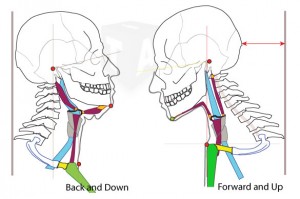
A certain use of the Head in relation to the neck , and of the head and neck in relation with the torso provides the best conditions for raising the standard of functioning…
For now, if you imagine the airway tube going up from the hilum of the lungs, nearer to the back than the front of the thoracic cavity, at the height of the second or third thoracic vertebra, to the back of his nose (the upper airway composed of naso-pharynx, oro-pharynx, laryngo-pharynx and trachea or windpipe), you must realise that in the geometrical conditions displayed on the right (“good use”), this long collapsible tube will be extended forward and up and not bent back and narrowed like in the use of the head and torso on the left.
This bending or opening of the airways tends to accredit the thesis that “head forward and up” could be a positive use of the anatomical structure, improving not only the general balance but also the breathing and vocal mechanism. We are going to explore this issue much further to understand Alexander’s claim that modifying the orientation of the different parts of his articulated torso changed the relation between his torso and head and ‘cured indirectly’ his voice problem.
An quick example of a reasoned analysis
Before starting a reasoning consideration of the causes of the conditions present10, I would like to show how easy it is to establish a reasoned analysis of the mechanical use of the self on a picture or in the reflection of a mirror.
On this photo of a flamboyant middle aged Alexander, we can now see that his stature is lengthening but that something is amiss. As a rule, I always communicate the ‘good relationships’ before getting to the geometry which needs conscious guidance (means-whereby instructions) to improve.
- His Ear is UP (away from the Throat —red dot on the top of the sternum bone)
- his Upper parts of the arms —green dots on the head of the humerus—) seem to be slightly forward of the Throat (a symptom of a widening upper back),
- the head is not pulled down toward the back as the Chin is directed toward the throat (he is “nodding is head down”),
- the Throat is very high (the top of the sternum is above the line joining both Upper Part of the Arm).
He looks tall and erect.
Yet again, we can see the double chin11 and the head is not forward but directly above the torso. The Ear (auditory canal) situated near the top of the spine (apparent only on a sagittal X-ray) is very far back relatively to his Throat.
We will see that from these criteria alone, we can safely deduce that the man is retracting the head relatively to the torso. The end result of his movements of the parts of the whole stature is that his head is Up and Back relatively to the torso, with the top of the windpipe pulled back and the larynx imprisoned far forward of the naso-pharynx (back of the nasal cavity and beginning of the airway tube).
He “looks tall”; nevertheless, this appearance is hiding the fact that, at this precise moment, he is not functioning to the best of his capacity.
In passing it is not negligible to mention that the picture was taken after 1930, long after Alexander invented his technique: we see that despite years of practice, he could still be caught in the act of reacting with the old erroneous sensory guided direction. The idea that one would “get it” after sufficient conditioning of the postural reaction or after having received the “correct sensory appreciation“12 seems to be refuted by the behavior of the master teacher himself.
The aim of this article is to help students reason:
- what *head forward and up* meant at the time Alexander started teaching and,
- what is the relation of the geometry between torso and head with the opening of the airways and the functioning of the breathing mechanism.
I am also going to explore the consequences —the connection which exists between cause and effect— of such end result on the two other ends that Alexander kept presenting as his concerted goals of the teaching of the use of the anatomical structure (Back-to-lengthen-and-widen and Neck-free).
In the individual the normal processes of education in the use of the anatomical structure are conducted subconsciously, certain instincts commanding certain functions, whilst other functions are conducted deliberately.
The effects of this haphazard process have either to be elaborated or broken down, according to the defects established by misuse of the mechanisms, and the first step in re-education is that of establishing in the pupil’s mind the connection which exists between cause and effect in every function of the human body. (Alexander, F., M., “Man’s supreme inheritance“, 1910, Charterson Ltd, Methuen & Co., p. 141.)
I will explain how this particular geometrical relation between head and torso is related to both his habits of shortening the stature and gulping in air. We will see how a poor geometry of mechanical advantage of the torso is sufficient on its own to create a vicious circle that was bound to affect his voice in time.
Conception or misconception of the relationship between head and torso
I will now start a reasoning consideration of the cause of the conditions present, i.e. a retracted head [toward the center-line of the torso], a tendency to suck in air, and a depressed larynx. I did not go really far to investigate the “cause”: I just carefully examined the conceptions of the use of the self proposed by the Alexander technique presence on the web.
In order to get my bearing, I just followed the quote below:
“In the performance of any muscular action by conscious guidance and control there are four essential stages :
- The conception of the movement required
- The inhibition of erroneous preconceived ideas which subconsciously suggest the manner in which the movement or series of movements should be performed“;
- […]. (Alexander, F., M., “Man’s supreme inheritance“, 1910, Charterson Ltd, Methuen & Co., p. 141.
Some of you may think that the conception of the movement required can only be obtained by the repetition of correct manipulations by an expert teacher. I started to question this belief long ago because Alexander certainly did not form his conception in this way. According to his books, he had to:
- reason out new verbal instructions because he inferred that what saw in the mirror was not conducive to good use and functioning, and
- include the correct “means-whereby” so that the process of carrying them out involved the satisfactory use of his mechanisms as a whole 13
A detail troubled me even more. All the first generation teachers had extensive manipulation-work done to them by Alexander, yet none ever wrote a paper explaining in reasonable terms the conception that lies behind Alexander’s choice to indicate the head-forward-and-up result as being the main symptom of good use. While they all repeated with authority that the head-forward-and-up is a sure sign of good coordination, none really did explain why nor what it really entails. When I started to play with the action-coding-system analysis of the photographs of the senior teachers, I became even more puzzled.
Head forward and up, yes, but from where?
- The third of August 1934, Irene Tasker made a report of a lecture Alexander delivered at the Bedford Training College. It is the only trace of Alexander explaining from where the head should be taken forward and up, i.e., a part of the back of the torso:
“What this young lady is doing now is a very difficult thing to do. She is directing her head forward and up from here (Alexander indicates with his hands a part of her back), he knees forward and the hips back, and that the only way you can get your antagonistic pulls”. (FM Alexander, “*Articles and Lectures”, “Bedford Physical training College Lecture”, Ed. Mouritz, p. 177 – 178).
I never heard a senior teacher describe the new use of the head relatively to the torso in such a precise form, i.e. in relation to an explicit landmark. Nor did any demonstrate in his/her use such a relationship.
This tend to show that receiving a correct sensory experience does not in itself create a clear conception of the movements required in the torso to produce such a result, not anymore that it constructs any solid guidelines in the self-guidance of the series of movements (means-whereby) necessary to obtain the result.
I understand that this statement may seem very arrogant, but I have met many of these teachers and I have a wide collection of photos in which they are seen giving turns or posing for a photograph with their head “back and up” (and sometimes back and down) relatively to the back of their torso. Near the end of this paper, you will see with your own eyes how Alexander exemplified Head Forward and Up from his back: you will come back to this photo and wonder….
What I am discussing and talking about here is the conception of the correct manner of use of the different parts of the torso. What is the proper shape, the result you seek to achieve when you mould the pupil’s body14 with your hands? The conception is that mold as sure as there must be a plan prior to its execution.
Alexander believed that this conception should be conscious.
But granting the subconscious its fullest degree of merit, we are forced to recognize its serious limitations in the mode of life (civilization) with its ever-changing environment which human progress demands. We must have a guiding principle without these limitations, to enable us to adapt ourselves much more quickly to the new environments which are inevitable in the progress of civilization towards its legitimate goal.
We must have something more reasoned and definite than that which subconscious direction offers, and so we come to the need of reasoned guidance. (Alexander, F.M., “*Man’s supreme inheritance*”, Chaterson Ltd 1910, reprinted 1946, p. 112)
Despite what many are preaching today about their “capacity to accurately feel and allow the correct use to be transmitted to their pupil“, intimating that they are allowing a subconscious, natural, embodied cognition to come out of non-doingness where the right-thing-does-itself without any planning or critical thought, it is amazing how loud the conception of the shape they are imposing on their pupils shouts from the photos of them working with their pupils. Further along, I will show a random collection of pictures of modern teachers and pupils and you will see that the mold is curiously fixed across countries and time and certainly not allowing each pupil to express its own ‘nature’.
As a reader of Alexander’s books, I never thought that the technique was a mean to express a fabled ‘nature’, but rather a cultural, reasoned guidance necessary to avoid the downside of the preliminary inertia of mind which tends to stick to the most salient feeling and sensation with no regard for the functioning of the whole.
Because of the strength of the subconscious conception transmitted by the hands-on moulding of the body, I will not consider the discourses which place “Head-forward-and-up” in the class of ‘intangible phenomena’ or spiritual non-efforts. As you well know, I am teaching a rational technique (mental principles and rules of construction) and tangible means whereby.15.
Of all the conceptions which lead to the conditions of head-pulled-back and depression of the larynx the main one is to be found in the modern ideas (conceptions) regarding the lengthening of the stature (looking tall and erect) and mechanical advantage (the use of the torso that should feel light and good!).
During my investigations, I realized that I had subconsciously learned during my training days through the teachers’ manipulation (hands-on) and table-work (sometimes called semi-supine or constructive rest) a perverted notion of Head forward and up which clashed with the other criteria of good use, i.e. a prevention of a depressed larynx and of a reduced mean thoracic capacity. Nowadays, I call this conception the “plumb-line use of the torso and head”.
The story of the modern conception of the balanced body
During the reasoning I am going to present, we should not forget that any conception of the position of the cranium relatively to the torso affects not only the whole spine (shortening the stature), but also
- the angle of the airways tube between the back of the nose and mouth and the lungs, and,
- the volume of the thoracic cavity.
In the “Use of the self” Alexander explains that he found that all these defaults, the geometric one (the retraction of the head relatively to the torso and the diminution of the mean thoracic capacity) and the functional one, i.e. sucking in or gulping in air, were directly related: for him, they had both to be checked in order to improve the condition of the voice and breathing mechanism.16
This is all well and good, but Alexander does not define in writing what he meant geometrically by “the tendency to put the head back“. We will see that, to this day, it is all but clear for his teachers.
Understanding the secondary symptoms, i.e. the depression of the larynx and the reduction of the mean thoracic capacity, is going to help us:
- realize the importance of a clear conception of Head forward-from-what and of a new geometrical relation between torso and head, as well as,
- define what Alexander called “back to lengthen”.
This link between the breathing mechanism and the carriage of the head in relation to the torso has not received the attention it deserved. It is at the root of Alexander exploration of the conscious use of the mind and it is the yardstick which can help us to reason out which conception of the use of the head in relation to the torso could be advantageous and beneficial.
The plumb-line misunderstanding
It is easy to replicate Alexander’s habitual, spontaneous reaction by arching the top of the torso back to pull the head back toward a vertical line passing by the middle of the back of the torso. Alexander called it “retracting the head” relatively to the back of the torso and he linked that habit of reaction to a common conception of lengthening the stature known as the “drill-sergeant’s chest” (Alexander, msi, p. 89) and the “plumb-line” monstrosity (Alexander, ucl, p. 56).
Before we start to examine the modern Alexander technique conception of going up which may lead to a depressed larynx, I would like you to observe the old “drill-sergeant plumb-line” description presented by Alexander in his first and last books.
I have added a few of Delsarte’s “psychological instruments“, i.e. colorized spots and geometrical lines which are not on the original photo — on this photo; the only line present on the original is the plumb-line itself, the black line going through the Ear, the 1st cervical vertebra and the ankle joint.
The purpose of the colorized visuospatial instruments is to help place different anatomical landmarks (definite spots on the bones) and geometrical lines, in order to consciously control the relations between the bony structures of the torso.
According to Alexander, this man is ‘lifting up‘ the chest. I do not find that this label adequately describes the use of the different parts of the torso. The expression translates quite well the intent of ‘going up’ which is at the source of the plumb-line conception, but it does not convey the movements of the top of the torso relatively to the movements of the middle and bottom of the torso.
This man is ‘lifting up’ the chest by pulling the top part of the torso back relatively to the middle of the torso: he is voluntarily arching his back by pulling the top of this back back.
Presenting such an extreme picture has the advantage to show clearly:
- how the line of the sternum (front part of the torso) corresponds to the top of the lumbar line (lifting the chest back toward the middle of the torso),
- how the spinous process of the first vertebra (blue dot) is pulled back behind the sacrum line (pulling the top of the torso backward toward the middle of the back).
There is a drawback though with such exaggeration. It is that no Alexander teacher would imagine being caught in such misuse of the parts.
Now that you have a clear and exaggerated conception of poor use, I will introduce the modern conception of good use which teachers of the modern Alexander technique put forth in their papers or websites.
In this way you may understand why I consider erroneous conception the modern attempts at representing the human anatomical structure. This is not an opinion, but the result of a process of experimentation with the “plumb line skeletons” that many teachers of the modern Alexander technique use in their teaching to depict good use. I will come back to this in a moment.
Unfortunately, this same erroneous conception or representation of the relationship between the head and torso has contaminated the servile medical copyists in their production of images for medical education: I intend to demonstrate that all the medical representations of the human upper airways are recreating the same incorrect retraction of the head relatively to the torso.
During my training days, no one thought to tell us —the students— that the academic anatomical iconography we were using to learn anatomy was presenting bad use! As you will see, it is more than obvious that our teachers did not understand the academical representation they were using to teach us anatomy. They were bringing into play medical charts without experimenting first what the representation really produced in practice. I think they never thought to experiment because they believed they had the correct sensory appreciation drilled into their sensory makeup.
It is only recently, with the advent of three-dimensional dynamic computer simulations and MRI of anatomical and physiological structures that the representations of the upper airways have started to show a very different picture of physiological appropriateness (good use) — much closer to the standard of functioning (good use) advocated by Alexander and, obviously, a different geometry between torso and head than the one people are used to see and consider ‘well-adjusted’ in the Alexander technique community.
The modern plumb line skeleton straighten the cervical spine
As I said, a number of modern Alexander teachers are presenting on their website or in different articles their idea of “good use“, “coordinated support” (Alexander, ccci, 1955 ed., p. 107) or “position of mechanical advantage” (Alexander, msi, 1917, p. 115). They are all trying to represent the correct stacking of bones, i.e. the End (end-result) they believe the modern Alexander technique is supposed to teach.
While I think that working with representations of the anatomical structure is a positive move in the direction of a rational or reasoned apprehension of the Technique, I must admit that I cannot understand their plumb-line skeleton other than as a result of a one-track idea with very little practical experimentation.
They all fell into the trap on confusing the finished product, the end result, with the attitude of inquiry which brought it to life: they are trying to get the student to digest a solution instead of developing the means to investigate the problem.
What is curious is that all these representations of the anatomical structure are made according to a type of “plumb line skeleton” in all aspects similar to the one which was presented by W. Conable (BodyMapping ®, or Andover Educators®). Such uniformity coming from different and unrelated groups of teachers in the States, the UK and Japan seems to argue for plausibility, yet there is an annoying fact: all their representations bear no little resemblance with the Drill-Sergeant profile criticized by Alexander.
This is a very common representation of what I call the modern plumb line skeleton; this one is from Body Mapping© found in the text of David Nesmith, “What every musician needs to know about the body“. http://bodymap.org/main/?p=276, but I could have chosen many others such drawings.
In this image, the author has provided a red line and shows how different joints are aligned on it. You are going to see that this red line is a plumb-line. The purpose of the arrow symbols at the back is not very clear to me, but it is possible to use the information at our disposal to create a practical experimentation and to test the model of “the Core of the body” , the “balanced body” according to Body Mapping.
This is the text which goes with the illustration:
“Our freest movement and consequently our freest breathing will only be available to the degree that we are balanced. Our bodies can be “postured” (shoulders back, chest out, tummy tucked, etc.), “collapsed” (slumped) or “balanced.” A “balanced” body utilizes our bony structure and postural reflexes for support of voluntary movement. It is that place from which movement in any direction is easiest. We experience balance when we make full use of mechanical advantage: bone in right relationship to bone“. (David Nesmith, )
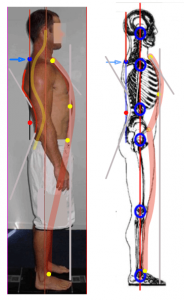
This is what the Body Mapping bone on bone would look like: the plumb line posture! I have added a sternum line, a sacrum-line, a upper-lumbar line and the vertical projection of the front of the chest.
If you wanted to consciously control the model of bone in right relationship to bone, the simplest way would be to experiment practically by following all the criteria presented on the model and consciously direct your torso according to it.
I have not created the photo of the practical experimentation myself, I have just taken a picture on the Web depicting the plumb line posture advertized by the physiotherapists as “criterion of diagnosis of good posture“. You will see that the photograph on the left seems to have been exactly constructed on the model of the plumb-line skeleton of Body Mapping (or is it the reverse?):
- The top of the back of the torso (blue dot on the 1st thoracic vertebra) is slightly backward relatively to the lumbar curve apex (see red dot); this indicates a marked shortening of the thoracic spine;
- The shoulder-blade is protruding back and the upper part of the arm is behind the ribcage17; this indicates a marked narrowing of the upper back;
- The top of the spine (just under the Ear) is on the plumb-line and, as a result, the back of the Head is further back that the vertical of the top of the back of the torso; this indicates a strong retraction of the head relatively to the torso;
- The sternum is inclined back at the top (see the grey construction line) as a result of the collapse of the lumbar upper curve necessary to bring the 1st thoracic vertebra (blue dot) in line with the back of the pelvis.
As this article deals with the depression of the larynx as a consequence of a retracted head, I will focus my examination to the relationship between the torso and head.
It is clear that a lot could be said on the kind of use that this imaginary relationship between torso and limbs represented on the complete model would lead to, but I will develop on this vast subject in an other article.
How the plumb line model interferes with breathing and phonation
The bone on bone or plumb line model model correctly depicts a straight cervical spine —aligned on the red line—, which correlates with the position of the chin backward relatively to the front of the chest. To understand the connexion in cause and effect between the form and functioning (between the geometrical use and functioning) I propose that we look now at an x-ray of a person displaying the medical condition known as “straight cervical spine“.
One of the most important symptoms which you will see on this X-ray is that the bodies of the cervical vertebrae are piled vertically, (on a plumb-line) a sure symptom of a serious medical condition known as “straight cervical spine” associated with neck pain, breathing problems, vocal disphonia and sometimes muscles spasms.
I choose this picture because:
- it is exactly similar to the cervical spine of the bone on bone model, (the angle of the top of the sternum tends to indicate that this is a consequence of lifting the chest up and back),
- it shows the aspect of the cervical spine when it is compressed and retracted,
- it exposes what Alexander was doing to the geometry of his breathing mechanism when he retracted his head (the upper airway is colorized in red).
Exactly as in the Plumb Line Skeleton of Body Mapping, the Ear (auditory canal) is far behind the vertical line passing through the Throat (top of the sternum), the surest sign that the head is retracted relatively to the torso.
In order to underline the effect of such form (geometry) on functioning, I have colorized in red the upper airways and marked with a red arrow the bending and narrowing of the tube at the entrance of the Larynx. The backward movement of the top of the torso, head and jaw does not only retract the head relatively to the torso, shortening and compressing the cervical spine, it also causes a partial obstruction of the fibro-muscular tube of the pharynx and a sharp bend at the entrance of the larynx (see red arrow on the X-ray above).
Looking inside the mechanism of a bended and narrowed airway
This diagram is a typical image used to teach the anatomy of the airways.
- (1) nasal cavity
- (2) Epiglottis
- (3) Tongue
- (4) Hypopharynx (and just under it, the beginning of the larynx)
- (5) Esophagus (digestive tract)
How are we to analyse this medical diagram of the upper airways?
When you look at a medical diagram on the internet or in a book, you should not accept it at face value. The reason for such comment is that most of the time, the doctors and scientists are not concerned nor knowledgeable about the best use of the parts. It is also clear that most representations used for medical training depict severe problems and dysfunctions to help students notice the problems.
Despite the accepted claim that “Understanding normal physiology provides the basis for recognizing abnormalities“18, in most anatomical charts found in medical texts, the general use of the head and torso is properly a misuse of the parts. Most x-rays you will find are also typical of a severe mis-use and dys-function.
And do not think that you are going to be on the safe side because a diagram or picture is proposed by a teacher of the Alexander technique in a book or article: very often they are just copying academic representations without having done the least work of research and objective experimentation of the mechanical truth of the diagram they employ.
It is necessary to train oneself to ‘read’ these representations and in this situation, the ‘action coding system’ is once again decisive in helping to make an appropriate judgment.
By now, you certainly have figured out my intent: this diagram does not present “good use” in all its ‘character’. It is an expression of a bad use with the head retracted and the airways collapsed: once again we are confronted with the plumb-line model.
- the bodies of the cervical vertebrae are almost piled vertically, indicating that the head is retracted toward the center of the torso on the sagittal plane,
- the pharynx is vertical, when we know that the other extremity of the airway, i.e. the hilum of the lungs, is in the back of the thoracic cavity: there must be a sharp bend after the larynx!
- the nasal cavity is clearly portrayed behind the entrance of the hypo-pharynx (we will see that in this condition the airways are not “free”) ,
- the Chin is lifted away from the Throat (the Head is therefore pulled down toward the back) and, finally,
- the larynx seems extremely high and protruding, a relative position that Delsarte demonstrated as being nocive for the phonation mechanism (there is an imbalance between the muscles suspending the larynx to the lower jaw -anterior belly of Digastric muscle and Mylohyoid muscle- and base of the skull (Mastoid and Styloid processes) -posterior belly of Digastric muscle and Stylohyoid muscle).
To support this interpretation, I present an x-ray displaying the same ‘plumb-line’ relationship between the head and torso: it is apparent that the head is retracted (a flat cervical spine is a very popular reaction) as the Ear (just above the top of the spine) is very far back relative to the front of the torso and the bodies of the cervical vertebrae are almost stacked vertically. There is a slight double chin (it is only small owing to the fact that we see a young singer).
At the same time, the larynx appears to be very high and bended backward: both conditions are present to foretell respiratory and voice problems. And indeed, this is the case as this example comes from a very interesting article on misuse of the “voice” by Soren Lowell which shows that the stimulus of speaking provokes a reaction in this subject who pulls the larynx-box UP toward the mouth every time she thinks of speaking aloud) direct link to the article by Soren Lowell.
On the x-ray it is therefore apparent that the back of the nasal cavity (1) — i.e. the entrance of the pharynx (the tube conducting the air to the larynx) — is backward relative to the opening of the airways (4) and larynx, inducing a bending of the tube in two places and an undue narrowing of the pharynx.
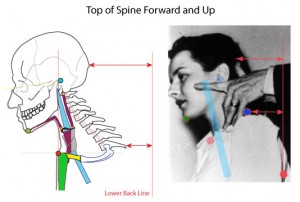
With or without manipulations, it is possible to coordinate the parts of the torso to extend the airways and prevent any bending or narrowing of the upper airways
For the airways not to be bended forward at the entrance of the larynx, the only solution would be to have the cervical column extending Forward and Up at the top.
On this picture showing Alexander manipulating a young lady, we can trace the direction of the top of the spine in relation to the lower back line. It is clear that Alexander is organizing the pupil in order to free the upper airways (to “free the neck”) from any bending and obstructions.
If you compare with the x-ray above of the young singer with breathing and phonation problems, see how the red trace in front of the upper spine —the beginning of the airways, pharynx and larynx— are contorted due to the retraction of the head, neck and top of the thoracic spine. It is apparent that the tube is narrowed and flattened as a result of the particular geometry of the thoracic and cervical spine.
Therefore, we can see that when the head is retracted relatively to the lower torso, there is a narrowing and a flattening of the tube (pharynx and larynx) behind the nose and mouth.
This picture of a bend tube does not depict a real situation: it is only a reminder of the geometry of a depressed tube.
We are now going to see what are the other mechanical conditions associated with the adjustment of the torso and head leading to a depression of the airways tube.
A biomechanical understanding of the “depression of the Larynx”
The geometry of the tube is not the only cause of the condition we are considering when helping a pupil find a solution to his misuse of the relationship between head and torso. There is also a functional problem associated with the habitual reaction of combating an obstruction of the airways by accelerating the speed of air.
It is important to realize that there will be a flux of air running in the tube during both phases of respiration (inspiration & expiration). To understand the behavior of such a system, you have to know that this is a case of “fluid mechanics” (particularly of “fluid dynamics”).
Owing to the venturi effect (the law of “fluid dynamics which is applicable in this case), a flow of air passing through a narrowing of a passage is accelerated: with the acceleration, there is a reduction of the pressure which the fluid (air) exerts on the wall of the tube. This reduction of pressure is also called ‘depression‘ (in French depression means ‘lack of pressure’ or negative pressure).
Venturi found that the flux is constant in any open tube: as a result, a flux at slow speed generates high pression on the wall of the passage while any bend or constriction of the passage will generate high speed and low pressure (i.e. depression) on the passage walls.
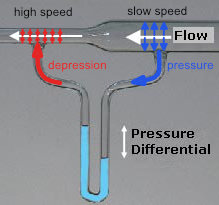
When air flows through a constricted section, there is an increase of speed and a reduction in pressure.
On this example showing a flux of air passing through a tube with a reduction in size, the column of liquid is much higher on the side of the reduction in diameter because, as the speed is higher due to the reduction in size of the tube, the pressure becomes negative in the small tube. If the Flow was faster (or the narrowing more marked), the water would be aspirated into the thin tube on the left and would continue to do so until complete obstruction –because of the resulting negative pressure or ‘depression’– creating greater clogging and obstruction and therefore, greater loss of pressure on the walls and more water suction.
The experiment above has been done with a rigid tube (glass). It is interesting to understand what would happen in the case of a breathing mechanism made of collapsible tubes surrounded by hollow cavities full of fluid (sinuses) when the pressure is less than the atmospheric pressure due to both a bending of the tube and an acceleration (gasping in) of the air.
In a collapsible tube, we will see that the venturi effect (narrowing of the tube= increase in speed of air and corresponding decrease in pressure on the wall of the tube) also increases the tube deformation in the direction of:
- a narrowing of the airways, and,
- an irritation of the mucous membrane.
Instead of re-inventing the modelling of Alexander’s employment of the word “depression”, I propose to read the brilliant bio-mechanical explanation of M. Matthias Heil : “Flow in collapsible tubes” (see fluid Structure interaction problem).
Here it is:
Flow in Collapsible Tubes
The figure below shows the deformation of a thin-walled elastic tube which conveys a viscous flow (the direction of the flow is from left to right).
In its undeformed state, the tube is cylindrical and the ends of the tube are held open (think of a thin-walled rubber tube, mounted on two rigid tubes). As we increase the external pressure [from (a) to (d)], the tube buckles and deforms strongly. The reduction in the tube’s cross sectional area changes its flow resistance and thereby the pressure distribution in the fluid, which in turn affects the tube’s deformation.
This is a classical example for a large-displacement fluid-structure interaction problem for which many applications exist in biomechanics (e.g. blood flow in veins and arteries, flow of air in the bronchial airways).
Conclusion
It is necessary to understand that when the habit of sniffing, gasping and accelerating the air in breathing has been developed by a subject, the ‘simple geometrical solution’ of directing the Head forward and up relative to the torso should not be sufficient to promote good use of the breathing and vocal mechanism. Both habits of pulling the head back and of accelerating the air flow have to be dealt with in the reeducation.
The young Alexander solution to the irritation of the airways
First Part: The indirect geometrical solution
Owing to his deep knowledge of the Delsarte System, Alexander quickly “found out” that the geometrical arrangement of the head relative to the torso was the major cause of his throat trouble. More importantly, Alexander realised that the prevention of the tendency to put the head back could not result from a direct order, but had to be obtained by an indirect procedure involving a series of concerted instructions.
To explain the concept of the ‘indirect solution‘, I will demonstrate that the cause of the geometrical problem lies not in the neck use but in the coordination of the different parts of the “centric joint” as Delsarte called it, i.e. the articulated mechanism of the torso. The problem of the depressed larynx is obviously “in the neck”, but the solution lies elsewhere, in changing the geometry of the torso and neck.
Alexander does not say anything else in the “Use of the Self”:
The functioning of the organs of speech was influenced by my manner of using the whole torso, and that the pulling of the head back and down was not, as I had presumed, merely a misuse of the specific parts concerned, but one that was inseparably bound up with a misuse of other mechanisms which involved the act of shortening the stature. If this were so, it would clearly be useless to expect such improvement as I needed from merely preventing the wrong use of the head and neck. (Alexander, F., M., “The use of the self”, “Evolution of a Technique”, p. 9)
How are we to understand this declaration?
It is clear that when the top of the thoracic spine (top of the torso) is pulled back in space relatively to the middle part of the torso as if to perform the conception of a plumb-line figure with a straight neck (straight cervical spine) – certainly in a spontaneous reaction to the stimulus to ‘go up’ and to ‘lengthen the back’–, then the base of the cervical spine (the 1st thoracic vertebra just below the 7th cervical) is pushed too far back, irremediably pulling the cervical spine and the head back toward the middle line of the torso, constricting the airways into a smaller place.
In that plumb-line geometry of the torso, no amount of wishing for the head to go forward and up or to nod the head down will achieve anything useful in terms of the relationship between the head and torso which could open the airways and prevent the depression of the larynx because in this rigid coordination of the different parts of the torso, any attempt to put the head forward would put it down and compress even more the airways.
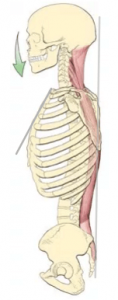
A well known Alexander technique website Dimon Institute illustrates Head Forward and Up with a plumb line skeleton.
Have a look at the picture used in the Dimon Institute Blog, a well known modern Alexander technique website in the US, to explain the meaning of “head forward and up”, from The Dimon Institute explanation of “Forward and Up”.
You will recognize instantly the “plumb line posture” (because the back of the head is aligned on the back line) and the fact that the back of the torso is neatly aligned, as if the skeleton had spend too much time lying down on a table top. I have added the grey lines to show the relationships between the middle and top of the back of the torso (1st thoracic vertebra pulled back) with the head and the angle of the sternum.
The model presents a straight cervical spine. Nothing seems to indicate that it is a medical condition (is it considered healthy?) and the solution proposed to get the head ‘forward’ lies only in the green arrow: according to Dimon, releasing the muscles of the back of the neck to nod is what ‘forward‘ means in the sentence “Head forward and up”, and the manner of using the whole torso is not considered at all.
See how the shoulder-blades are retracted toward the spine —the upper parts of the arm are not represented, but it is clear that the thorax where the lungs are situated is seen to be in front of the arms, instead of being, as it should be, behind them (Alexander, msi, p. 166). When the back is narrowing like this, the intense shortening of the major muscles linking the Head and the Shoulder-blades cannot but pull the head toward the back of the torso.
According to the Dimon Institute Blog, the “forward” position of the head, i.e. the nodding forward, is obtained by merely preventing the wrong use of the head and neck. You are told that, if you stop the tightening of the neck muscles (direct action), the head shall nod “Forward”. In the written explanation next to the image, the meaning of the word “forward” is clearly not linked with the manner of use of the mechanism of the torso:
In a general way, we know that “forward and up” of the head means that we don’t want to pull the head back and down. But why do we use these words, and what exactly do we mean by them–that is, what do we mean by the “forward” and what do we mean by the “up”?
>We’ve already seen that the skull sits on the atlas, or top vertebra of the spine, and nods at this point. This gives us an idea of what the “forward” refers to. Because we tighten the neck muscles and pull the head back, we have to stop this tightening to allow the head to nod forward at the AO joint between the ears, and put the extensors in the back of the neck on stretch; that’s the “forward”. (“The anatomy of Directing, Forward and Up“)
This proposition is clearly utterly different from Alexander’s statement indicating that it is the manner of use of the whole torso which affects the vocal organs and the pulling of the head back and down.
I admit that it is possible that the graphic artist working for the Dimon Institute may not have the knowledge to interpret the anatomical drawings presented. Yet, there is an unmistakable pattern: on a different article of the same blog, the “monkey position” presented is also portraying the retracted head of the plumb-line conception with a straight upper thoracic spine and a straight cervical spine.
When you compare the Dimon Institute representation of Monkey Dimon Institute: the anatomy of lengthening the front length with Alexander’s performed monkey, the difference is obvious: in Alexander’s photos, the placement of the neck is not caused by the neck itself, but below, by the new voluntary conformation of the main thoracic curve. The coordination of the torso is totally different.
You can look at all Alexander’s pictures. In his conscious use of the parts of the torso, the first thoracic vertebra is never aligned with the back line; the head is therefore very far forward from the “place of the back” he was referring to in the Bedford Lectures in 1934.
This explains why Alexander insists in remarking that “merely preventing the wrong use of the head and neck” is useless.
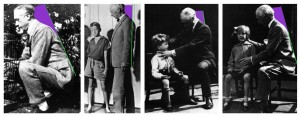
Alexander’s first thoracic vertebra is always forward of the back line. His torso is clearly articulated with a different principle than the ‘plumb-line’.
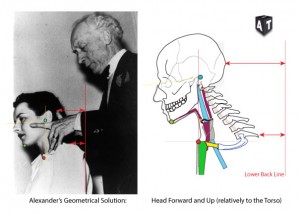
In order for the spot “Ear” (green) to be so near the vertical line of the spot “throat” (red), the top of the torso cannot be aligned on the back of the torso.
It is only by reeducating the direction of the use of the different parts of the torso that the spine as a whole can allow the cervical spine and the head to be in the ‘position’ [relationship to the torso] which Alexander used to impose with his hands on the body of his pupils to free their airways and neck.
On this picture, next to the diagram showing the opening of the upper airways as a result of the new organization of the top of the torso (base of the neck) in relation with the lower back line, it is clear that Alexander is manipulating the pupil in order to achieve what he is doing with the different parts of his own torso.
On this particular subject, Alexander never wavered in all his books and established the concept of the indirect solution as a central principle.
If there is any undue muscular pull in any part of the neck, it is almost certain to be due to the defective co-ordination in the use of the muscles of the spine, back, and torso generally, the correction of which means the eradication of the real cause of the trouble.
This principle applies to the attempted eradication of all defects or imperfect uses of the mental and physical mechanisms in all the acts of daily life and in such games as cricket, football, billiards, baseball, golf, etc., and in the physical manipulation of the piano, violin, harp, and all such instruments. (Alexander, F.M., “Man’s supreme inheritance“, Chaterson Ltd 1910, reprinted 1946, p. 127)
In another article which I will publish shortly (“What do I see“), I proposed a complete analysis of a few Alexander portraits taken while he was manipulating pupils: it is clear that he was ‘shaping’ his pupils to obtain the same form of the torso as the one he obtained by following his conscious and indirect model, this same form which would propel the head forward and up without any direct intervention.
Alexander was also certainly pulling (gently) their head forward “in place”, but, had he be more patient, he would have noticed, as I did, that by just changing his/her direction of the mechanism of the torso, a pupil will unknowingly bring the head in the relationship with the torso shown below by Alexander.
I instruct every teacher having Skype lessons with me on how to create that experiment for themselves and for their pupils. As every lesson is taped for future work and conscious control, the teacher gets a visual demonstration that by consciously directing the movements of the different parts of the mechanism of the torso (without ever directing the head), the head is moved indirectly to a new ‘position’ relatively to the lower part of the back.
When you know all this, you cannot look at pictures of the modern conception of the Head relation to the torso in the same way. The time of Alexander is now long past and it is interesting to contrast Alexander’s use of the parts of the torso, neck and head with the one of his distant relatives: the modern Alexander teachers.
The internet is full of pictures of Teachers of the modern Alexander technique and it is clear that their conception of the movements of the parts of the torso is now totally different from the one which guided the old teacher, when he was working with himself as well as when he was working with someone else.
Just look at the relationship between the top of the back of the torso and the neck and you will see the conception of the plumb-line monstrosity (as Alexander used to call it), with a straight cervical spine, a mechanically depressed larynx and, as we will see later, a restricted mean thoracic capacity.
Are these modern teachers not supposed to feel (embodied cognition) what is right for their pupil? Are they not deep in contact with mindfulness, drinking at the source of the natural poise in the here and now?
The head-forward-and-up technique has become the straight-neck-back technique. The direct line of transmission embodied in touch seems clearly at fault, especially when you understand the reasoning behind the original or initial idea of the relation between use and functioning.
A rational use of the torso projects the head forward and up from the back to open the airways
On this photo of Alexander giving a lesson in 1932 (I have hidden the pupil to focus the attention on Alexander’s form), it is for all to see that the relative position of the head to the back cannot be spontaneous, especially because we know beyond doubt that this man had a strong sensorimotor habit to pull the head back relatively to the torso.
It is also clear that the head is forward from the back of the torso, not by a direction of the neck in relation to the head alone, but because the thoracic cavity (in the torso) is ‘respected‘ and not unnaturally straightened by pulling the top of the torso back in an attempt to lift the front of the chest up.
I have added a blue dot on the spinous process of the first thoracic vertebrae to show clearly that this use of the mechanism of the torso is completely different from the ‘plumb line conception’ of going up in which the 8th vertebrae (orange dot on the diagram) and the 1st are on the same line.
See how far the top of the back of the torso is from the line of the lower part of the back of the torso. It is only because the first thoracic vertebra is projected forward that:
- the head can be so far forward without being pulled down, and,
- the sternum is not inclined backward at the top, but clearly parallel to the front of the torso.
The geometry of the back and the relationship with the head is striking and cannot be mistaken with the flat table back of the modern plumb line skeleton.
As everyone knows, the thoracic curve of the spine belongs to the torso: as this curve is fundamental to obtain the new relationship between the head and torso contributive to an opening of the airways and a correct suspension of the larynx, then the functioning of the organs of speech is really influenced by the manner of use of the mechanism of the torso and certainly not by any direct non-effort to free the neck.
On this picture, there are two fundamental points:
- the first thoracic vertebra is very far forward from the line of the lower back or back-line (this is certainly the origin of the expression/order “let the back back“);
- the first vertebrae in contact with this ‘back line’ (the orange line which shows how Alexander is directing the lower part of the torso) is the 8th one (and certainly not the first thoracic at the top of the torso as in the plumb-line skeleton).
As a consequence of this adjustment, the front of the torso presents a very unusual, straight shape and not the rounded shape that is so prevalent nowadays with the sternum pointing forward at its lowest extremity (first image on the left below). Alexander is displaying a geometry of the torso such that the sternum line is aligned with the front of the 8th rib (frontal plane of the torso) and the anterior superior iliac crest (Iliac).
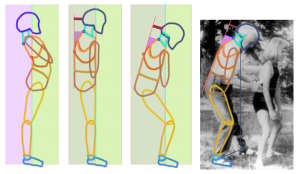
This is a “block analysis” of the plumb line skeleton versus Alexander’s conscious use of the mechanism of the torso.
Articulating the top of the torso in a new relation to the other parts of the torso is the only way to comply with the old Delsarte’s instruction to align the ear, throat, upper part of the arm, front of the ribs and front of the pelvis to present an “active chest”. In these conditions, it is clear that the head is forward and up relatively to the back line of the lower torso.
As I have already pointed out, this in turn implies that the sagittal line of the sternum is not inclined relatively to but parallel with the front of the torso.
I have every reasons to believe that this organisation of the four parts of the torso was called “position of mechanical advantage” by the young Alexander. As I have explained elsewhere, it is not a “position” but a geometry, i.e. a set of relationships between different bony structures of the torso which can only be attained by a concerted series of movements (the means-whereby lengthening and widening the back) and which can be adapted to almost any gesture provided the movements of the different parts of the torso are consciously coordinated to maintain the “shape” in motion.
The position of the shoulder-blades is easy to define, because the upper-parts of the arms are forward of the rib-cage as requested by Alexander (Alexander, msi, 1945 ed., p. 166): this is the means-whereby the upper back is widened. I point this obvious fact to the reader to remind him/her to the fact that most of the written comments on geometric adjustments Alexander has made in his books can be experimented upon and falsified when necessary (it is not the case here).
Lengthening the spine is not obtained by trying to achieve directly a “straight-back torso and neck”: aligning the whole back of the torso on a door side or on a table cannot be an expression of what Alexander meant by lengthening the back with “good use”. The “lengthening and straightening of the back” has to be determined in function of the prevention of the depression of the Larynx.
Second Part: Lengthening to increase the mean thoracic capacity
Alexander’s explanation of his solution is a reminder that the breathing mechanism is dependent on the global direction of the practical will:
Now in dealing with this case, many parts of the organism will require readjustment. The spine must be straightened and lengthened, the mean thoracic capacity permanently increased in order to give free play to the internal organs, and the firmly established habit of drawing breath by sucking air into the lungs must be broken. (Alexander, F.M., “Man’s supreme inheritance”, Chaterson Ltd 1910, reprinted 1946, p. 122, «The Processes of Conscious Guidance and Control»)
Too little attention has been given to the series of criteria of good use prescribed by Alexander. The concept of “straightening the spine” has completely overshadowed the other linked concepts of “preventing the depression of the larynx” and of “increasing permanently the mean thoracic capacity“. The one-track brain has led the conception of the use of the self toward a plumb-line or table straight line. If our teachers had studied Alexander’s written explanations with a mind keen on experimenting, i.e. without fear of “end-gaining”, they certainly would have realized how each criteria limits and specify all other criteria of good general use of the self.
Therefore, when reading the quote above, it is important to exert discrimination regarding the adjective “straightened”. “Straightened” should not be taken literally: I sometimes see teachers gently pressing the top of the torso and the shoulders of their pupils on a table. I will now use this same quote to demonstrate that “Straightening the pupil as a table top” should be recognised as BAD USE because it does not only depress the upper airways (see previous chapter), but it also severely diminish the mean thoracic capacity!
In support to this terrible allegation against lying down on a table top, I will put forward three arguments (I have added the photographs of Alexander because I was afraid that some who dislike Alexander would think he represents a special case and that his way of using himself is not a model of the result he described as back to lengthen and widen and head forward and up):
- As a first visual argument, I already presented 9 photographs of the master teacher, from whose it must be clear to anyone-who-can-see, that “straightening” the thoracic spine did not mean in his idea and cannot mean flattening the thoracic curve and pulling back the top of the torso on the back line, and,
- second, I will show that, to comply with the second rule of adjustment advocated by Alexander, i.e. the mean thoracic capacity must be permanently increased, we should stop pulling the top of the chest up and back,
- Third, the reason that so many teachers are advocating a Plumb Line model could be that they are in fact conceiving the Table-top idea of lengthening the back as an ideal of upright coordination: the two models are so similar that it is possible that they did not see the trap.
In order to permanently increase the mean thoracic capacity, or vital capacity, defined as the maximum amount of air a person can expel from the lungs, there is only one way to “straighten” the torso : the upper thoracic curve must be respected when coordinating the movements of the parts of the torso. Lengthening must be obtained, but without lifting the chest UP and Back.
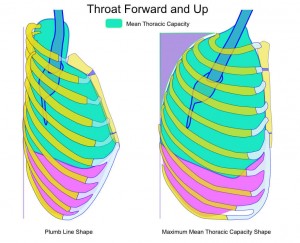
Modeling the mean thoracic capacity gives a correct indication of the proper lengthening of the back.
The diagram on the left shows the habitual plumb-line ribcage (or if you view it flat and not vertical, you see the ribcage of a human lying down on a table): the top of the back of the torso is on the same line as the back of the lower part of the torso, the sternum is down (first rib going down) and is inclined backward at the top. The mid-ribs are flaring forward and the upper half of the ribcage is less than the other half.
As a direct result, in the plumb line diagram (on the left), the front of the chest is lifted back but the sternum is not lifted at all: the lungs are compressed by the collapse of the front of the ribcage, thereby reducing the mean thoracic capacity to a minimum.
The second drawing (on the right) is a replica of the ribcage displayed by Alexander’s shape of the torso when seen working with the little girl. The back of the first rib is very far forward from the back line and the front of that same rib is very far away (up) from the front of the pelvis: the sternum is lifted Forward and Up and all the inter-costal muscles are lengthened. The sternum is not bended anymore and is vertical. Behind, at the top of the back of the torso, the purple triangle is a reminder of the curved shape Alexander is presenting in all his pictures.
I have represented the ‘hilum of the lungs‘ where the trachea (the airway tube) is connecting with the lungs. It is then possible to see the angle “forward and up” of a free trachea.
Remember that the lung are attached on all sides to the ribcage via the pleura. It is not difficult to estimate which of the two diagrams represents the maximum increase of the mean thoracic capacity: can anyone doubt that the general capacity of the bag is a sure sign of the standard of efficiency? Alexander introduced this same demonstration in his first book:
Let us, for a moment, think of the thoracic and abdominal cavities as one fairly stiff oblong rubber bag filled with different parts of a working machine which are interrelated and interdependent, and which are held in position by their attachment to the different parts of the inner surface of this bag. We will then suppose, for the sake of our illustration, that the circumference of the inner upper half of this bag is three inches more than that of the lower half. As long as this general capacity of the bag is maintained the working standard of efficiency of the machinery is indicated as the maximum.
Let us then, in our mind’s eye, decrease the capacity of the upper part of the bag and increase that of the lower half until the inner circumference of the latter is three inches more than the former. We can at once picture the effect on the whole of the vital organs therein contained, their general disorganization, the harmful irritation caused by undue compression, the interference with the natural movement of the blood, of the lymph, and of the fluids contained in the organs of digestion and elimination. In fact we find a condition of stagnation, fermentation, etc., causing the manufacture of poisons which more or less clog the mental and physical organism, and which constitutes a process of slow poisoning. (Alexander, F.M., “Man’s supreme inheritance“, Chaterson Ltd 1910, reprinted 1946, p. 11)
Therefore, the idea of lengthening the whole back of the torso and head on a door side or a table top is certainly not promoting good use, but a general disorganization. Lying down has never promoted an ‘active chest‘ as it is an attitude in which the standard of functioning is closer to sleeping than any other human activity.
When Alexander was working on a pupil, imposing his guidance with his hands, as on the image below, it is clear that he was always coordinating the movement of the head forward with the increasing of the mean thoracic capacity, bringing the sternum more and more vertical by guiding the first thoracic vertebra forward (I call this “respecting the upper thoracic curve”) of the line of the lower back.
Alexander working on the upper part of the back of the torso to change the habit of pulling the upper chest back.
Alexander is working to bring her head more forward-and-up relatively to the back line of the lower torso by guiding her torso in a more extended position of the top part of the back in relation to the lower part of the back.
I look at the shape of his right hand on the upper part of the torso of the pupil: he is expanding the horizontal distance between his little finger and his thumb, thereby re-arranging the top of the torso in relation with the back line to increase the thoracic upper curve.
With his right hand, Alexander is clearly working to increase the curve of the top of the torso in order to give the pupil the maximum mean thoracic capacity and also to help open the thoracic curve to project the head forward and up and, indirectly, prevent the depression of the larynx.
With his left hand, he is just maintaining the cervical spine in connexion with the angle of the upper thoracic curve. It is not this left hand which is creating the movement of the head forward and up: the movement comes from the new coordination of the parts of the torso.
As far as I can see, this pupil is still pulling her chest up and back: her Ear is still a long way behind the vertical line of her Throat (top of the sternum) and she has the stiff cervical line indicating that her neck is not free.
The instruction “back back” did not mean straightening the top of the torso, i.e. “pulling the top of the chest back” as some do when they want to “look Alexandroid” (there is no resemblance between Alexander directing his torso and the Alexandroid form). Pull the back back can be understood when one remembers the Bedford Lecture (see J.O. Fisher, “Articles and Lectures”, p. 177) where Alexander explains:
She is directing her head forward and up from here (Alexander indicates with his hands a part of her back), he knees forward and the hips back, and that the only way you can get your antagonistic pulls.
This is not a quote dating from the early texts: it is posterior to the opening of the first training course.
A little bit of controversy
“You only escape ambiguity at your own expense” (Cardinal de Retz, 1613-1679, quoted in “Mémoires du Cardinal de Retz, de Guy Joli et de la duchesse de Nemours”, ed. 1820).
As a consequence of the deductions presented in this paper, i.e. that it was fundamental that the first vertebrae should not be aligned with the back of the torso to achieve the “head forward and up result”, as soon as the year 2000, I started to explain [in a STAT meeting in France] that prescribing lying down on a table should be abandoned because it encourages a kinaesthetic imprinting of a wrong use of the mechanism of the torso and as surely, it prevents the students from ever finding out by reasoning what were the connected end-results (“Head forward and up”, “Free Larynx” and “Maximum mean thoracic capacity”) of the means-whereby instructions as exemplified by Alexander self-practice in action.
I let you imagine what could be the reaction of the tradition-bound society of teachers of the modern Alexander technique! (this explains why you haven’t heard of me for the last 15 years). After fifteen years, some Alexander teachers still turn their head away in order not to salute me! And imagine that at the time, I was still manipulating the pupils in the modern Alexander way. Many senior teachers who do not know anything of my work call me a “charlatan” just because I teach the Alexander technique over Skype: if they knew that I have not taught semi-supine for fifteen years, they would certainly find the word too sweet.
For fifteen years, I have kept these ideas for myself and I never taught the lying (untrue) semi-supine again. My lessons are all exactly sixty minutes, and the pupil (teacher or not) is only involved in experimenting with his conscious guidance of the movements of his torso in relation with the limbs (neck, arms, legs), without a minute to spare.
Look at a picture of Alexander directing his use of the torso in the best of conditions (this occurs apparently every time he his manipulating a pupil) and see how far he consciously directs the top of the torso forward from the middle of the torso, thereby expanding the thoracic capacity (I explain this in great details in the article “What do I see”) and indirectly projecting his head forward, just above his sternum and front of the torso. Any other way to “put the head forward” would put it “down”.
His sternum is NOT projected back at its upper extremity: would Delsarte place one of his wooden ruler on this sternum, it would be vertical in standing at ease!
Now examine this image from the Stat Website:
“The regular practice of lying down in the semi-supine position will help in encouraging the changes sought with the Alexander Technique, and is invaluable for maintaining a healthy spine. It is a way of giving yourself a ‘little Alexander lesson’”. Stat Website
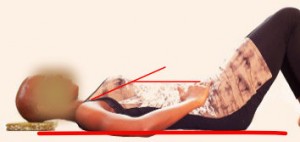
The picture advertised by the STAT website: the sternum is inclined backward at the top, the upper part of the arm is pulled back behind the ribcage, and the upper torso is pulled back to lie on the table. Turn the image 90° and you get the plumb-line conception alright!
When lying down in a relaxed state on a firm surface, it is impossible to keep the top of the torso away from the line of the lower back. It is therefore a kind of inactivity which reduces the upper part of the thoracic cavity to a minimum and pulls the head back in relation with the back of the lower torso.
The head is pulled back, not because of a lack of height of the books underneath the head, but because the upper thoracic spine is prevented from lengthening forward away from the middle and bottom part of the torso, thereby reducing the upper thoracic curve.
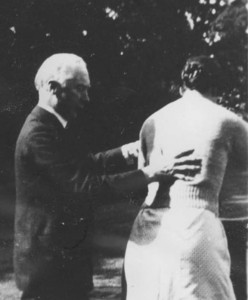
For the back to widen, the upper part of the arms must be directed forward of the chest: “With the arms hanging vertically, the relative position of that part of the thorax where the lungs are situated will be seen to be in front of the arms, instead of being, as it should be, behind them“. (Alexander, msi, p. 166)
Also, in this relaxed state, with the shoulders ‘resting’ on the table behind the ribcage, the all important opener of the chest (the serratus anterior) is forever kept out of play. On the semi-supine photo, the upper part of the arm (head of the humerus) are clearly in line with the back and not forward of the chest: the muscles of the back, connecting the sacrum to the arms and the spine to the shoulder-blades are not widening. This is clearly not what Alexander is promoting in the real life activity of putting the hands on the back of a chair. See how far forward around the ribcage this lady has her shoulder-blades and ask yourself this question: “knowing the number of muscles attaching the head to the shoulder-blades, it is rational to believe that the head can go forward and up when the habit is to pull the shoulder-blades back?
Why would Alexander promote such a procedure as semi-supine? This is a question which I could not answer.
I give many Skype Lessons to teachers and students all over the world and it is a fact that all of these teachers, despite having received hundreds of hour of manipulating work, had no idea to start with of the relation between the shape of the back and the shape of the front of the torso: none presented the characteristic topology of Alexander upper chest and head position relatively to the torso when he is seen giving a turn. They all displayed a sternum line pointing back at the top, an upper torso lifted back, and upper arms behind the ribcage, exactly as if a table had imprinted a straight line on their back of the torso. Is a surprise that all of them practiced regularly the ‘semi-supine relaxation’ in contact with the here-and-now?
Can you hear the sound of breathing in?
This article demonstrates that, with his habit of pulling the upper chest back relatively to the middle of the torso (of if you prefer to pull the head back relatively to the middle of the torso), Alexander’s airways must have been chronically narrowed and irritated. Most people experiencing the same situation of clogging of the airways would react impulsively and try to accelerate the breath. The same unthinking reaction is triggered by a runny nose for example. It is the ‘natural’ reaction (naive reaction) to sneeze and/or produce a violent (fast) aspiration[6]. Both solutions accelerate the air flow and, as we have seen with the Venturi explanation, increase the problem.
It is only by reasoning out the cause of the conditions present that it is possible to see an issue to the vicious circle, but the procedure of change of such behavior is not straightforward: the conscious mind must be quickened so that the subject is capable of making a fresh judgment based on reasoning when the problem occurs again and again. The first part of the solution is not to be found in breathing lessons. The use of the torso has to be changed first.
I watched and listened the other day to a video of a famous modern AT teacher advertising her lessons of breathing re-education (on YouTube). The top of her torso was pulled back all the time according to the plumb-line conception, preventing her upper thorax to be expanded correctly. My attention was instantly drawn to the fact that she was making an awful lot of noise to take a breath through the mouth at the end of each sentence: I did not raise the volume at all to hear her gasping for air at the end of each phrase, be it long or short.
“If the “ deep breath ” be taken through the nasal passages there will be a loud “ sniffing ” sound and collapse of the alas nasi, and if through the mouth, a “ gasping ” sound. The pupil has not been told that if the thorax is expanded correctly the lungs will at once be filled with air by atmospheric pressure, exactly as a pair of bellows is filled when the handles are pulled apart”. (Alexander, F.M., “Man’s supreme inheritance”, Chaterson Ltd 1910, reprinted 1946, p. 195)
It is a fact that she was seriously pulling her sternum back (shortening of the back and obstructing the airways) and therefore lifting her chest back in a masterly way. She said she wanted to share a new method of breathing invented recently which completed her knowledge of the Alexander technique. I wondered about that. All the while, she was unknowingly accelerating the breath to compensate for the geometrical obstruction (in taking the air in), the very defect Alexander wanted to eradicate at the start of his Evolution!
These attempts at doing something to bring the air in or at removing liquid from the nose and at ‘clearing’ the throat may work in a specific manner, but the simple venturi law dictates that the acceleration of breath in sucking or vocalizing in these conditions produces a severe depression of the airways, and a resulting suction on the mucous membrane lining the airways, therefore creating the conditions for even more obstruction and irritation.
For the same reason, any voluntary effort to ‘breathe in’ without coordinating the mechanism of the torso paves the way to obstruction.
It is easy to understand that the repetition of such experience of the misuse of the head and torso geometrical relation would lead to a subconscious conception (misconception) of the act of breathing in everyday activity.
Once the torso is coordinated, manipulate the speed of air
And the process by which this [correct breathing] is achieved is simply a readjustment of the parts of the body by a new and correct use of the muscular mechanisms through the directive agent of the sphere of consciousness. This change brings about a proper mechanical advantage of all the parts concerned, and causes, thanks to the right employment of the relative machinery, such expansion and contraction of the thoracic cavity as to give atmospheric pressure its opportunity. Now here we have (a) the directive agent of the sphere of consciousness, and (b) the use of the muscular mechanisms-— the combination causing certain expansions and contractions, and the result being what is known as breathing. It will at once be seen, therefore, that the act of breathing is not a primary, or even a secondary, part of the process, which is really re-education of the kinaesthetic systems associated with correct bodily postures and respiration, and will be referred to universally as such in the near future. As a matter of fact, given the perfect co-ordination of parts as required by my system, breathing is a subordinate operation which will perform itself. (Alexander, F.M., «Why we breathe incorrectly», 1909. cited in Man’s supreme inheritance, pp. 88-89)
To finish with this article, let’s see the solution dictated by Delsarte and adopted by the young Alexander: project a connected series of verbal directions (a series of orders), i.e. guide the practical will in order to project an image of yourself in the mirror according to the conscious plan19 and, then, manipulate the speed of air.
- keep an active chest: prevent chest sinking. Do not let the chest shape obtained as an indirect consequence of a new coordination of the parts of the torso change with breathing, and,
- keep a conscious manipulation of the speed of air: willing or manipulating the speed of air in the airways to a minimum, both during the exhalation and the inhalation, will increase the pressure on the airways to maintain them open and also prevent the irritation of the mucous membrane.
According to Delsarte, this ‘self-manipulation’ of the parts of the torso and of the flux of air should be performed:
- by projecting simultaneous geometrical orders to your ‘reflection’ (the image you project in a mirror), thereby bypassing the faulty sensory appreciation conundrum and also,
- by “preventing the upper chest from falling” during the expiration (directing the chest to its full capacity in expiration and inspiration prevents the air from rushing away). 20
Without doubt, you will recognize here the combined conditions of the Whispered Ah procedure.
The nocive acceleration of the breath is audible. It is a physical manifestation. To achieve a solution, the mechanical principle (venturi principle) dictates:
- to widen the passage (“head forward” –ear on the vertical of the sternum– and up –away from the sternum–) (because any narrowing in the passage of a fluid will accelerate the speed and diminish the pressure on the walls of the tube), and also,
- to consciously manipulate (slow down) the speed of the air.
Letting the air IN without any noise (the system is adapted to the speed associated with the influx of the atmospheric pressure into the “empty” expanded lungs, and controlling the “economy of the OUT breath” with a controlled sound at the slowest speed possible (whispered Ah). This is exactly the Delsarte’s way of breathing: breathing with an expanded mechanism of the torso. To achieve this gestural movement, Alexander was obliged to consciously guide the mechanism of the torso or, in other words, the primary control of the use of the parts.
Re-written in the South of France, April 2017.
To finish this article on the economy of breathing, I would like to recommend the book of mister Alex D. Murray, “ALEXANDER’S WAY, Frederick Matthias Alexander, In His Own Words and in the Words of Those Who Knew Him”, 2015, Alexander Technique Center, Urbana.,, p. 29. follow this link to the book.
Thanks to mister Murray’s enormous work, here is very early article of F.M. Alexander on voice production. I have a special interest in this text: you will discover that at that time, F.M. was using the word ‘manipulation’ in the sense of “to direct the practical will in a rational way”. Here it is:
“Do not let the air RUSH”
“Proper breathing is undoubtedly the very first study that should claim the attention of the would-be singer and speaker. When I mention proper breathing, I do not refer to inhalation only, but to the combined acts of inhalation and exhalation. From the voice-user’s standpoint the one is useless without the other. After the lungs are filled, the air must be controlled, not allowed to rush away as soon as the mouth is opened to vocalize, as is the case with all singers who have studied the ordinary systems. It cannot be otherwise when the upper chest is falling in from the moment the mouth is opened to vocalise and the muscles intended by Nature to control and economise the air in vocalizing are prevented from doing duty by this imperfect mode of expiration.
Chest-sinking during the act of singing has another serious aspect. While vocalising chest tones the vibrations of the vocal ligaments cause the air-column in the windpipe to vibrate, which renders the tones fuller and richer. If the windpipe can rest against a solid chest wall, the tones will be rounder. If the chest is not kept firm, the windpipe loses its support, becomes unsteady, and the tone will sound uncertain and lacking in fullness.
Economy in exhalation is the great secret of gaining vocal perfection, and Nature has provided muscles to regulate control without in any way causing the least strain to the throat. In dealing with the matter of exhalation from this point I will call the act (when speaking or singing) manipulation. By manipulation I mean the throwing of the air back upon the vocal chords after the inhalation. Upon this throwing back of air upon the vocal chords the quality, power, etc., of the voice depends. There are two modes of correct manipulation, the one for speaking, the other for singing; and when they are applied an improvement in the voice is at once apparent to the most ordinary listener. After the manipulation has been perfected the student must turn his attention to the proper formation of the resonance cavities which convert the tone into the different vowel and other sounds necessary in vocalization. Helmholtz calls the mouth the resonance cavity for the formation of vowels. And with this foundation voice-cultivation can be attempted without fear of harming the human voice.
Singers and speakers who attempt to cultivate the voice without this foundation do all their vocalising and breathing with the muscles of the throat, and, consequently, at least seventy-five percent of vocal students suffer with throat troubles.Dr. Lennox Browne says:
“Each day I live I am more convinced that the method of inspiration—but more particularly the economy of expiration—is of the first importance in the production of all vocal tone, and that faults in the method of breath-taking and breath-emissions are at the root of the throat diseases of singers and speakers which come under my notice.”
(Alexander, F.M., “The Human Voice Cultivated and Developed for Speaking and Singing” (Sydney: c. 1900), 9–11. Booklet, copy from Jackie Evans to Alexander- D. Murray).
Jeando Masoero is a STAT certified Alexander teacher (1997) but not a member of STAT- He teaches the initial Alexander technique in one-to-one or group lessons, on Skype, and in workshops. He is currently writing a book on “The decisive influence of François Delsarte on the young F.M. Alexander”.
The initial Alexander technique or iAt is a replica of the principles and rules which the young Alexander learned from Delsarte’s brother to construct an efficient use of the parts of his anatomical structure with clear, explicit instructions for the mind. Instead of providing an experience of “good use” to the pupil by way of manipulations, the iAt teacher helps the pupil to construct a cyclical process of self-readjustment by subjecting his practical will to the command of his verbal will.
iAt is a method to develop “thinking in activity“, i.e. the habit of reflective thought in the pupil. The pupil has no idea that he can change his future behavior by a careful process of planning. The pupil needs to conduct experiments of self-guidance to discover that his own thinking can be creative and that creative thinking can lead him beyond previous experiences.
You have heard the saying: to “think from the known to the unknown” 21. This is the idea behind the concept of “thinking in activity”. To say it simply, the habit of reflective thought helps the pupil to plan, i.e. to self-change the future of his behavior. Can you think of a habit of behavior you would like to change? The habit of reflective thought will do the trick.
The iAt teacher is not going to change any habit for you. He will teach you what it is to reason in activity.
iAt is not body-work. It rejects the “somatics” discourse and it opposes the anti-rational movements known as “mindfulness” or “embodied cognition” which seek to put the flexible working of the true consciousness out of action in order to reach the subconsciousness (the primitive mind of sense).
“Briefly, all three methods seek to reach the subjective mind by deadening the objective or conscious mind, and the centre and backbone of my theory and practice, upon which I feel that I cannot insist too strongly, is that THE CONSCIOUS MIND MUST BE QUICKENED. It will be seen from this statement that my theory is in some ways a revolutionary one, since all earlier methods have in some form or another sought to put the flexible working of the true consciousness out of action in order to reach the subconsciousness. The result of these methods is, logically and inevitably, an endeavour to alter a bad subjective habit whilst the objective habit of thought is left unchanged”. (Alexander, F.M., “Man’s supreme inheritance”, Chaterson Ltd 1910, reprinted 1946, p. 31)
iAt refuses the separation of Mind and body and all the movements which advocate the deadening of the conscious reasoned mind, in order to reach for the subjective, subconscious mind of sense.
iAt teaches rational thinking and intelligent guidance, proposing to develop the higher executive functions in order to influence the lower functions.
Footnotes
- “How do you know Alexander is depressing his larynx on a photo?
- “I saw that as soon as I started to recite, I tended to pull back the head, depress the larynx, and suck in breath through the mouth in such a way as to produce a gasping sound. (Alexander, F.M., “The use of the self”, Integral Press 1932, reprinted 1955, p. 6)“.
- That the orders to be dictated by the teacher and mentally rehearsed by the pupil are of two kinds:
(a) Concerning definite inhibition.
(b) Concerning definite performance.
I may briefly explain (a) by stating that the teacher will have to deal with incorrect movements unconsciously performed. These movements, occurring at the moment when he dictates the orders necessary to bring about co-ordination of the different parts of the mechanism, assert themselves and become primary and hinder the performance of the correct and co-ordinated movements as ordered.
It is, therefore, as necessary to order the inhibition of incorrect and unconsciously performed acts as to give orders which will secure the co-ordinated use of the mechanisms involved. Therefore, when the teacher has discovered the errors unconsciously committed by the pupil when beginning to rehearse the correct orders, he will draw attention to them, and give a definite order concerning what is not to be done, e.g., the peculiar bad habit, perhaps, of a lifetime. This negative order must precede all positive commands. In other words, the order or orders concerning what is not to be done are to be considered as primary, and those concerning what is to be done as secondary. (Alexander, ‘Man’s supreme inheritance’, Original Edition, Paul R. Reynolds, 1910, p. 197). - “The ‘power of the word’ is a literal scientific fact. Through the operation of our thought forces we have creative power. The spoken word is nothing more or less than the outward expression of the workings of these interior forces.
The spoken word is then, in a sense, the means whereby the thought forces are focused and directed along any particular line, and this concentration, this giving them direction, is necessary before any outward or material manifestation of their power can become evident“. (Trine, R. W., « In tune with the infinite, Fullness of peace, power and plenty », 1897, p. 7). - This change in my conception of the human organism has not come about as the outcome of mere theorizing on my part. It has been forced upon me by the experiences which I have gained through my investigations in a new field of practical experimentation upon the living human being. (Alexander, F.M., “*The use of the self*”, Integral Press 1932, reprinted 1955, p. 1).
- Delsarte, François (1811, 1871), French teacher renewed for his System of Gestural Training which F.M. Alexander taught officially from 1896 to 1904. After arriving in England, Alexander was struck by total amnesia and the inheritance was forgotten.
- The ‘gesture’ or concerted movements of the parts of the anatomical structure can be analysed and described explicitly by using Anatomical Landmarks on the bony structures of the skeleton and geometrical relations between these spots. Delsarte used wooden rulers to concretize these geometrical relationships between the bones and he taught his pupils how to become the architects or their own gestures by ordering with accurate instructions precise simultaneous series of movements in mirrors.
- “It seems also to me that practice so called is so rarely directed by a reasoned analysis on a reasoned plan. Nor does the teacher analyse and instruct with accuracy. He demands from the pupil merely imitative, not reasoned acts. This makes practice so often futile for the imperfectly co-ordinated person, and teaching both halting and inadequate”. (Alexander, F.M., “Man’s supreme inheritance”, Chaterson Ltd 1910, reprinted 1946, p. 125).
- Bernsteĭn, N. A. “The Co-Ordination and Regulation of Movements“. Oxford; New York: Pergamon Press, 1967, p. 6).
- The “means-whereby” principle, on the other hand, involves a reasoning consideration of the causes of the conditions present, and an indirect instead of a direct procedure on the part of the person endeavouring to gain the desired “end.” (Alexander, F.M., “Constructive conscious control of the individual”, Integral Press 1923, reprinted 1955, note p. 5)
- in the teaching of iAt, we do not consider the double chin as the appropriate criteria of the retraction of the head: to assess this misuse of the Head relative to the torso we consider the “levers” topology, i.e. the bones relative ‘positions’, using precise anatomical landmarks : when the head is pulled back (retracted) relative to the torso, the spot Ear is back relative to the vertical of the Throat (top of the sternum)..
- “I tell a new pupil he is shortening his spine, and in attempting to lengthen it he invariably shortens it still more. The action is one over which he has neither learnt nor practised any control whatever. He is simply deluded regarding his sensations and unable to direct his actions. I do not therefore, in teaching him, actually order him to lengthen his spine by performing any explicit action, but I cause him to rehearse the correct guiding orders, and after placing him in a position of mechanical advantage I am able by my manipulation to bring about, directly or indirectly as the case may be, the desired flexibility and extension. The process is of course repeated until the pupil gains a new kinaesthetic sense of the new and correct use of the parts, which become properly co-ordinated, and the correct habit is established. He will then no longer find it easy to cause his physical machinery to work as it did before the fault was thus effectively eradicated“. (Alexander, F.M., “Man’s supreme inheritance”, Chaterson Ltd 1910, reprinted 1946, p. 129).
- It is only when instructions include the correct ” means-whereby ” that the process of carrying them out involves the satisfactory use of the psycho-physical mechanisms concerned.(Alexander, F.M., “Constructive conscious control of the individual”, Integral Press 1923, reprinted 1955, p. 68).
- “I am able to re-adjust and to teach others to re-adjust the human machine with the hands; to mould the body, as it were, into its proper shape, and with an open-minded pupil it is possible to remove many defects in a few minutes, as, for example, to change entirely the production of a voice, its quality and power“. (Alexander, F.M., “*Man’s supreme inheritance*”, Chaterson Ltd 1910, reprinted 1946, p. 115).
- “Now of the working of these mechanisms it is possible to acquire some tangible knowledge; […] The history of man’s efforts at every stage of his development furnishes proof of the harmful results which accrue whenever the human creature attempts to respond to a stimulus (or stimuli) arising from his conception of a phrase which represents intangible phenomena. How can this be otherwise ? How is it possible for him to come into possession of any tangible means whereby he may secure an intangible “end” ?” (Alexander, F.M., “Constructive conscious control of the individual”, Integral Press 1923, reprinted 1955, p. 44).
- “My experience up till now had shown me : [1.] that the tendency to put my head back was associated with my throat trouble, and [2.] that I could relieve this trouble to a certain extent merely by preventing myself from putting my head back, since this act of prevention tended to prevent indirectly the depressing of the larynx and the sucking in of breath”..
- “With the arms hanging vertically, the relative position of that part of the thorax where the lungs are situated will be seen to be in front of the arms, instead of being, as it should be, behind them. In such a position, the boy feels helpless, and tires rapidly, owing to the imperfect co-ordination, and any attempt to accustom him to this erect posture will ultimately result in deterioration rather than improvement”. (Alexander, F.M., “Man’s supreme inheritance”, Chaterson Ltd 1910, reprinted 1946, p. 166).
- Sahin-Yilmaz, A. & Naclerio, R.M., “Anatomy and physiology of the upper airway”, 2011, p. 2.
- “I have already advised you to the use of a mirror, so I counsel you to give your reflection these lessons, and I beg you to be strict with her or him“. (Stebbins, G.“Delsarte System of Expression”, NewYork: Edgar S. Werner, 1885, p. 89).
- “Such defects could not exist if the thoracic mechanism performed the functions ordained by Nature. The motive power for the respiratory act belongs solely to the thorax; and the existence of this natural action ensures that the throat and neck muscles, the larynx and the shoulders remain passive; the breath will pass noiselessly into the lungs, while those passages will be dilated instead of being contracted“. (Alexander, F.M., quote from Murray, A., D., “ALEXANDER’S WAY Frederick Matthias Alexander, In His Own Words and in the Words of Those Who Knew Him”, 2015, Alexander Technique Center, Urbana.,, p. 29).
- This result does not come about by inducing self-hypnotism, or because of some chance happening, as, for instance, the coming into contact with an outside influence, personal or otherwise, or the possession of some natural aptitude (habitual reaction) which is fitted to produce a certain desired result. In all these cases instinct rather than the thinking and reasoning processes is relied upon, whereas “reasoning from the known to the unknown,” as in my technique, depends upon the conscious employment of means that conform to biological, physiological, and other laws known to us; in which, also, the observation of phenomena in cause and effect can be tested according to strict scientific method, so that, as Dr. Dewey writes in his Introduction, “the causes that are used to explain the consequences, or effects, can be concretely followed up to show that they actually produce these consequences and not others.” (Alexander, CCCI, p. viii).

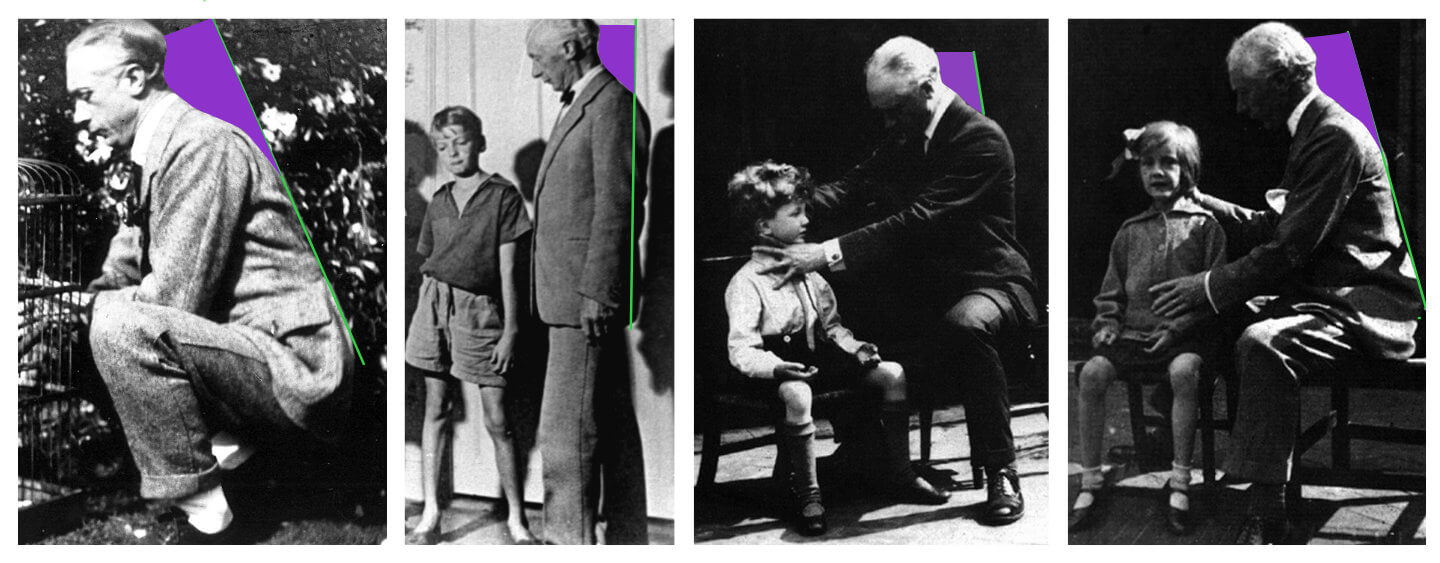
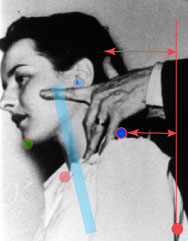
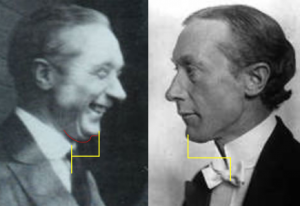
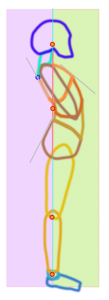
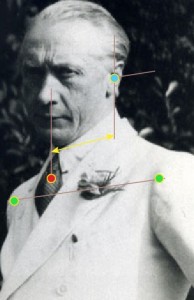

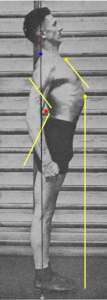
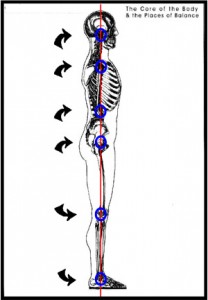
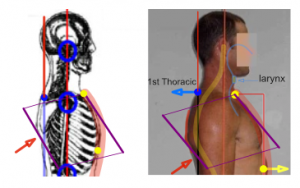
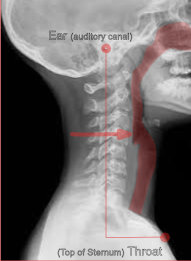
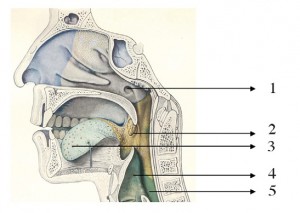
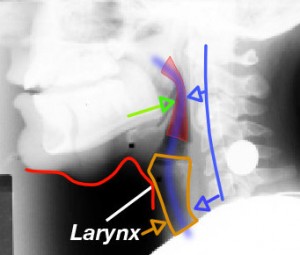
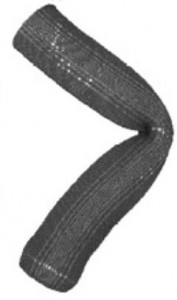
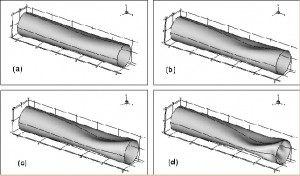
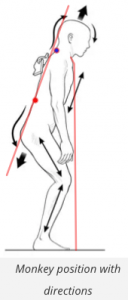
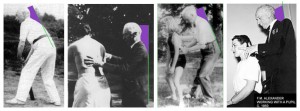
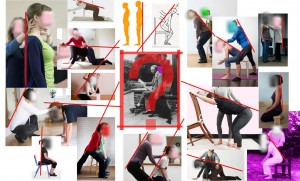
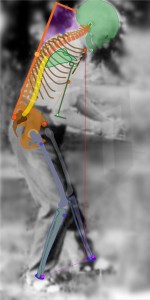
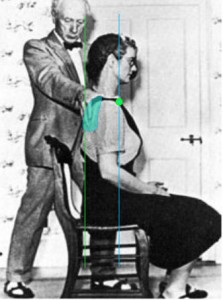
Wonderful work! Amazing and instructive
“Authoritarian manipulations”? On the training course we attended together, run by Ray Evans and Ron Colyer? Well, yes, Ray did speak of the merits of a benevolent dictatorship, but Ron? Ron was and is about the least authoritarian/manipulative human being I have ever met!
Apart from that, thank you for the blue tube which I found illuminating, and one short observation as follows:
While using her hands, with great delicacy and accuracy, to put deeper meaning into the words “head forward and up,” Nelly Ben-Or would sometimes say, “From there we want it.”
I came to understand that “there” was not an anatomical or geographical place. Not a part of the body susceptible to geometrical analysis. “There” was somewhere in the depths of my being.
Now I come to think of it, “There” is the place where I hold on to the idea that, like Jose Mourinho, I am the special one!
It is not a question of X marks the spot. I hold on to that idea with my whole being.
So I agree with your criticisms of the plumb-line models. But as so often when we point the index finger at others, there are three fingers pointing back at us.
Hi Jeando,
I’m going to make some inquiries on this blog if that’s ok?
Regards the following:
“This link between the breathing mechanism and the carriage of the head in relation to the torso has not received the attention it deserved. It is at the root of Alexander exploration of the conscious use of the mind and it is the yardstick which can help us to reason out which conception of the use of the head in relation to the torso could be advantageous and beneficial.”
…was this link in fact part of what Alexander wrote about in his earliest articles?
Hi Jeando, thanks for this, I enjoyed reading it and I’m looking forward to some space to respond, carefully!
A couple of quick, random thoughts, nothing to do with Delsarte, just from my own experience
1 Table work, I have found is a very mixed blessing. I use the table 0r floor for semi supine infrequently and find I come together quite well when I do not lie down at all for long periods.
2 I have often wondered about the shape of FM’s head and neck in this and other pictures and how it is indeed markedly different to some current teachers and their students.
3 I discovered the relationing of parts (FMs phrase) of the torso was more of an indicator and useful tool than addressing the head and neck relationship solely, or even from the beginning. That was quite a few years ago….but it is still an issue
4 My voice and clarity of breathing is a major feedback for my assessment of my own ‘use’.
5 I am troubled, too, by the ‘flatfish back’ conception and see it as a form of over control and emotional repression.
6 As a violinist, I have considered the area of head and neck quite a lot. The picture of musicians sitting with very straight upper backs is disturbing to me, despite having been a good model of this in my early days with the technique 🙂
7 We are still, I feel, ‘brutalised by doing and not ‘trusting to the thought…….i.e doing the directions in ever more subtle ways and backing this up with clever analysis, or throwing any analysis to the wind!
Hopefully I can respond more fully in the next week or so.
Interesting article! You are quite comfortable criticizing others so i hope you don´t mind asking you the following question:
As Alexander wrote that sucking air in through mouth is sign of bad use i wonder why you exhibit that exact behavior in your interviews?
Reading your article it seems you should know and have the means whereby to inhibit that bad use of yourself!
Do you think it is just a matter of time to change that or do you don´t know how to change that?
This article does not explain what Alexander meant by ‘the depression of the larynx’. In Man’s Supreme Inheritance.Alexander says:
“But the matter becomes seriously harmful in, let us say, such actions as singing and speaking, for when the mouth is opened with this unconscious and absurd expenditure of force, the neck is unduly stiffened, the head is thrown backwards, the larynx unduly and harmfully depressed, and thereby in a position most unfavourable to good vocalization. As I have for years pointed out and demonstrated in my own practice, from these ill-considered tensions spring the different forms of throat and ear trouble which are so common and which so frequently defy ordinary or for that matter extraordinary and highly specialized medical treatment. By inducing a proper conception of the right method of opening the mouth, I can command in the patient, and, what is more important, teach him to command in himself, a free condition in which the larynx tends to be slightly raised and relaxed instead of tightened and depressed; whilst there will surely follow, and that with a minimum of effort, a greater mobility of the facial muscles and of those of the lips and tongue so essential to good and clear enunciation and vocalization.”
(Mouritz 196 p.144)
The ‘depression of the larynx’ is the lowering of the larynx due to excess muscular tension.
Subsequently, the article fails to give a rational explanation of the relationship between the depressed larynx and the pulling back of the head.
Otherwise, thanks for a thought proviking article.
Regards,
Halvard Heggdal
Thank you for your clear explanation and diagrams/pictures.
Do you think the AT has anything to do with the resting tonus of the muscles?
Some I’ve read seam to think its about changing that back to what nature intended.
Good overall analysis, but the diagram shown under “The Impact on the Larynx” is confusing! What is the stylohyoid muscle doing in the second image? Why is it not lifting the larynx as the head goes forward and up, and how is it folding under the chin?
Thanks for writing this thought-provoking and detailed article. I have been teaching Body Mapping for over 15 years, and am now one of five Sponsoring Teachers who are responsible for training and licensing others to teach Body Mapping. I was horrified to see the photograph you posted representing your interpretation of our teaching of good balance, the “plumb line skeleton.” Seeing the photograph, I immediately saw someone exhibiting a pulled back posture, that would be limiting. Even without reading your explanation, my years of teaching guided me to see a neck that was too stiff and arms that were held back. Of course, most important, is the fact that when teaching balance, we do not seek to teach a static position. This is one of the biggest problems we experience with using the plumb line illustration: it discourages an active approach to balance, an understanding that balance is dynamic and more about the internal relationship of parts, rather than the look of the body’s exterior. For this reason, many in the Body Mapping world are questioning the use of the compression model altogether, and advocating a biotensegrity model of the body instead. The main value of this illustration, however, is to help with understanding weight delivery. When one understands how the body’s architecture allows us to release weight to the floor, then one’s relation to gravity changes, and forward and up becomes possible. BTW, we recently hired a graphic artist to more accurately draw images for us. We now have a new plumb line illustration, which does a better job of showing the curves of the cervical spine, and its relationship to the whole back. However, I think it still does not accurately show the dynamic relationship you describe in your article. I’m not certain any static picture can. I feel strongly that the sensory experience of the relationship of the curves of the spine to head balance, as well as an exploration of free breathing, as you advocate, are key to finding a healthier use of the self. Thank you again for your fine work.
Quote: “He is currently writing a book on “The decisive influence of François Delsarte on the young F.M. Alexander”
Is the book still in progress?
Is there an email sign up list to notify interested people when the book is available? if so then please add me.
I find the information already presented in your articles very illuminating regarding Delsarte I think the only thing I would like to see is more indications of specific sources so that interested parties can delve in themselves. Delsarte seems to be particularly difficult to research due to a sparsity of original documentation, I understand that but where it makes sense I would like to be able to delve into the source material.